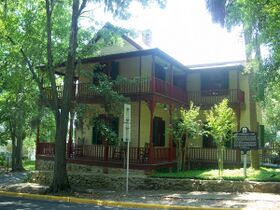Engineering:John Gilmore Riley House
John G Riley House | |
 | |
| Lua error in Module:Location_map at line 522: Unable to find the specified location map definition: "Module:Location map/data/Florida" does not exist. | |
| Location | Tallahassee, Florida |
|---|---|
| Coordinates | [ ⚑ ] : 30°26′21″N 84°16′39″W / 30.43917°N 84.2775°W |
| NRHP reference # | 78000950[1] |
| Added to NRHP | August 1, 1978 |
The John Gilmore Riley House is a historic home in Tallahassee, Florida. It is located at 419 East Jefferson Street. On August 1, 1978, it was added to the United States National Register of Historic Places. It is now known as the John G. Riley Center/Museum of African American History and Culture.[2]
History
Constructed circa 1890, the Riley House is the last physical evidence of a thriving middle-class African-American community that existed in downtown Tallahassee at the turn of the 20th century known as Smokey Hollow.[3] The house, a two-story vernacular wood-framed home, remained in the family until 1970.[2]
More than a historical landmark, the house is a noble witness to progress and the ability of its owner to succeed despite the odds. Unlike many other historic facilities in Tallahassee, the Riley House has humble beginnings. There was no dramatic transfer by will; neither did it come with a trust account or other means to help sustain operations or address perpetual needs of maintenance and security.
The house was almost destroyed in the 1960s due to eminent domain but was saved through the actions and hard work of local residents and activists.[4] The Riley House was restored in 1981[4] and in 1982 the Florida NAACP partnered with the Riley Foundation to purchase the house.[5] The museum opened in 1996 with Althemese Barnes as the founding director,[4] who retired in 2020.[6] Barnes is responsible for creating the group who developed the commemorative shotgun homes of Smokey Hollow in Cascades Park, across the street from the museum.[4] Barnes also interviewed and recorded hundreds of interviews with former residents of Smokey Hollow.[4]
Present
The museum is open to the public Tuesday through Thursday and offers guided tours which includes a tour of the Smokey Hollow Commemorative Park.[2] The museum features an animatronic, speaking figure of Riley, donated by Disney.[4]
In 2021, the museum received a grant from Institute of Museum and Library Services to digitize "the voluminous archive at FSU and TCC's Riley Museum Archives of photos, documents, rare books, oral histories and artifacts that document the history of Black Floridians in Leon and Gadsden counties."[7]
John Gilmore Riley
John G. Riley was a prominent member of the African-American community in Tallahassee. He was born a slave in Tallahassee on September 24, 1857.[8] When slavery ended, Riley pursued his education and became an educator himself.[8] He began his teaching career in 1877 at a school in Wakulla County.[9] From 1892 to 1926 he was the principal of the Lincoln Academy, which was the first secondary school in Tallahassee open to Black students and one of only three Freedmen schools in the state to offer higher education to formerly enslaved people.[10] This school was later named Lincoln High School. Along with his career in education, Riley was a prominent member of his community. Riley served as Grand High Priest of the Royal Arch Masons of Florida, a fraternal organization.[10] He also served as the Secretary of the Florida NAACP and was a Member of the Negro Business League.[11] Riley purchased seven major properties in Tallahassee, on one he built his home[9] and rented several properties to other families.[10] Some of his land ended up being the future sites of the Department of Natural Resources, Bryant Building, and the parking lot of the Florida State University Law School.[2]
John Gilmore Riley died a millionaire in 1954 at the age of 97.
References
- ↑ "National Register Information System". National Register of Historic Places. National Park Service. July 9, 2010. https://npgallery.nps.gov/NRHP.
- ↑ 2.0 2.1 2.2 2.3 "Riley House Museum". Archived from the original on 2007-03-03. https://web.archive.org/web/20070303021435/http://www.rileymuseum.org/about.htm. Retrieved 2007-05-20.
- ↑ "The Riley House – As a Community Museum and Educational Center". 25 February 2021. https://rileymuseum.org/history-founders/.
- ↑ 4.0 4.1 4.2 4.3 4.4 4.5 "The John G. Riley House is all that Remains of Smokey Hollow. Althemese Barnes Turned it into a Museum on Tallahassee's Black History". 27 April 2023. https://www.museumarchipelago.com/85.
- ↑ Taylor, George (27 April 2023). "John Gilmore Riley House Marker, Tallahassee, FL". George Lansing Taylor Collection Main Gallery. https://digitalcommons.unf.edu/historical_architecture_main/3282/.
- ↑ "Black history museum Riley House's Althemese Barnes retires, new director named". 27 April 2023. https://www.tallahassee.com/story/news/2020/10/27/tallahassee-black-history-museum-director-retires-new-director-named/6038964002/.
- ↑ "Riley Museum awarded grant to digitize collections in partnership with FSU, TCC". 27 April 2023. https://www.tallahassee.com/story/news/2021/11/17/riley-museum-awarded-grant-digitize-collections-fsu-tcc/8649125002/.
- ↑ 8.0 8.1 "Florida Frontiers: The John G. Riley House Museum". 27 April 2023. https://myfloridahistory.org/frontiers/article/55.
- ↑ 9.0 9.1 "John Gilmore Riley: Rose to Prominence as an Educator and Civic Leader". 27 April 2023. https://blackthen.com/john-gilmore-riley-rose-prominence-educator-civic-leader/.
- ↑ 10.0 10.1 10.2 "Eight of Florida's First African-American Millionaires". 27 April 2023. https://www.moderncities.com/article/2020-apr-eight-of-floridas-first-african-american-millionaires.
- ↑ "John G. Riley Center & Museum of African-American History and Culture". 27 April 2023. https://www.tallahasseearts.org/venue/john-g-riley-center-museum-african-american-history-culture/.
External links
- Riley House Museum - official site
- Leon County listings at National Register of Historic Places
- Florida's Office of Cultural and Historical Programs
- Podcast Featuring Interview with Althemese Barnes, Founding Director of the Museum
 |



